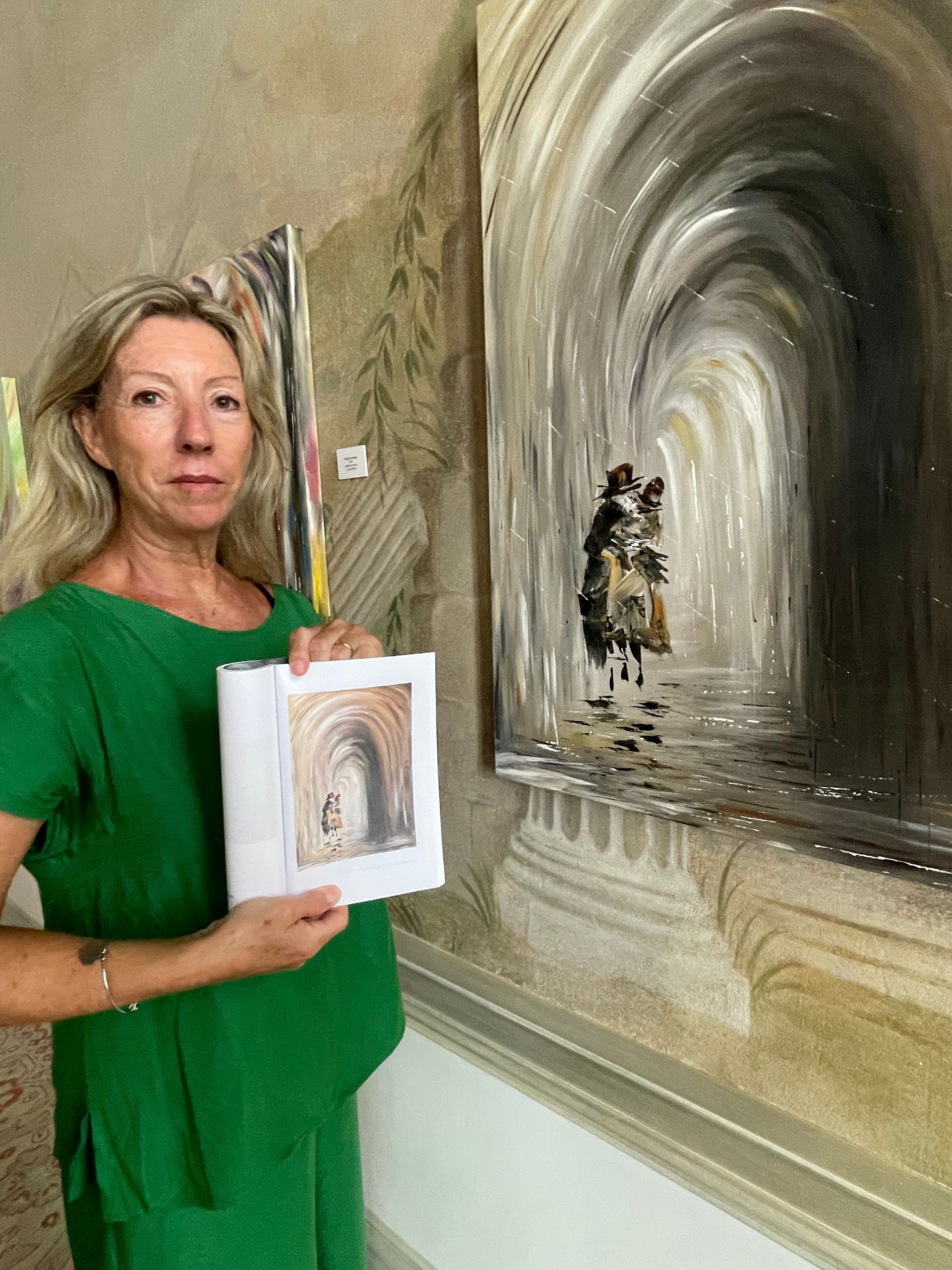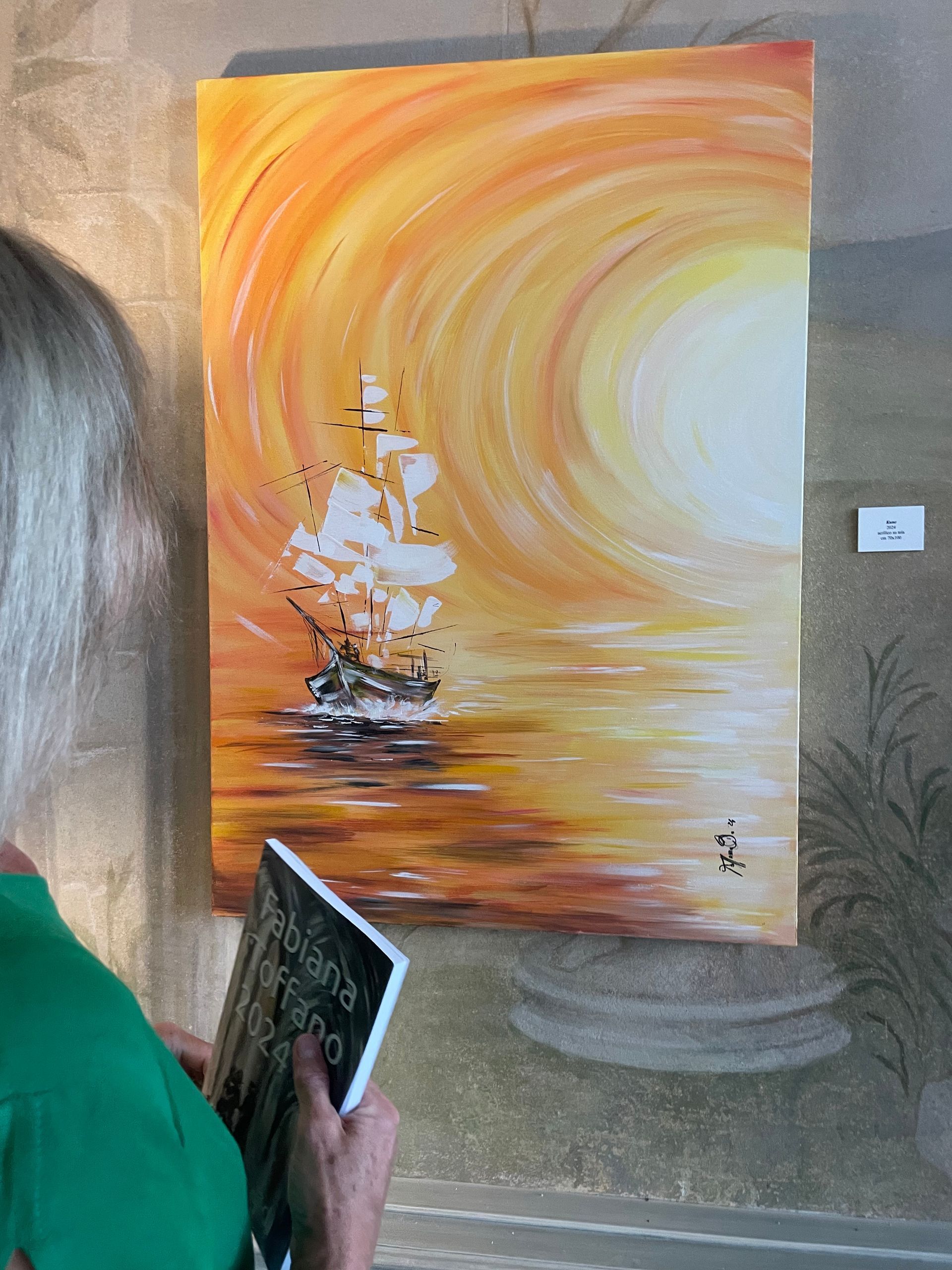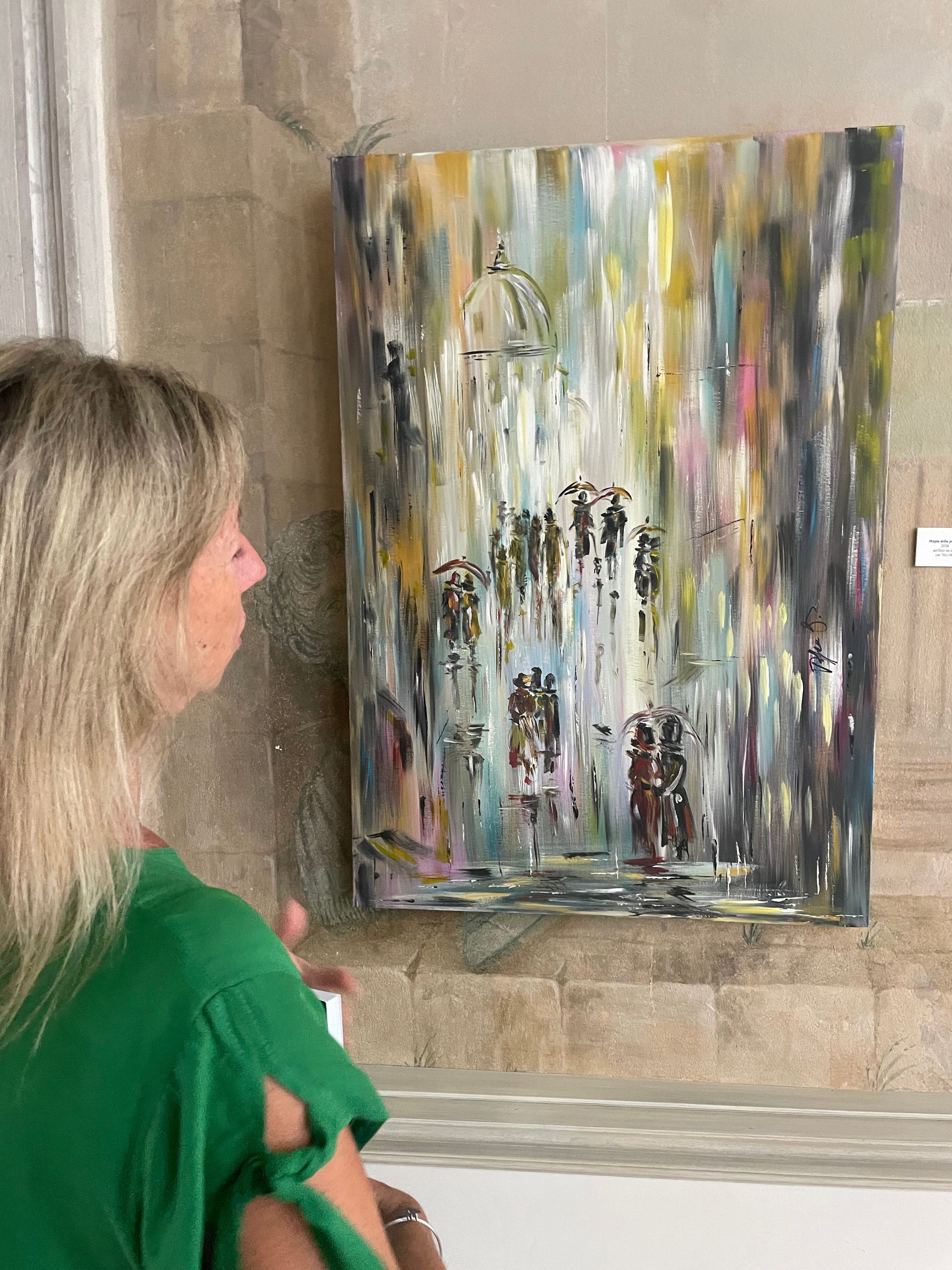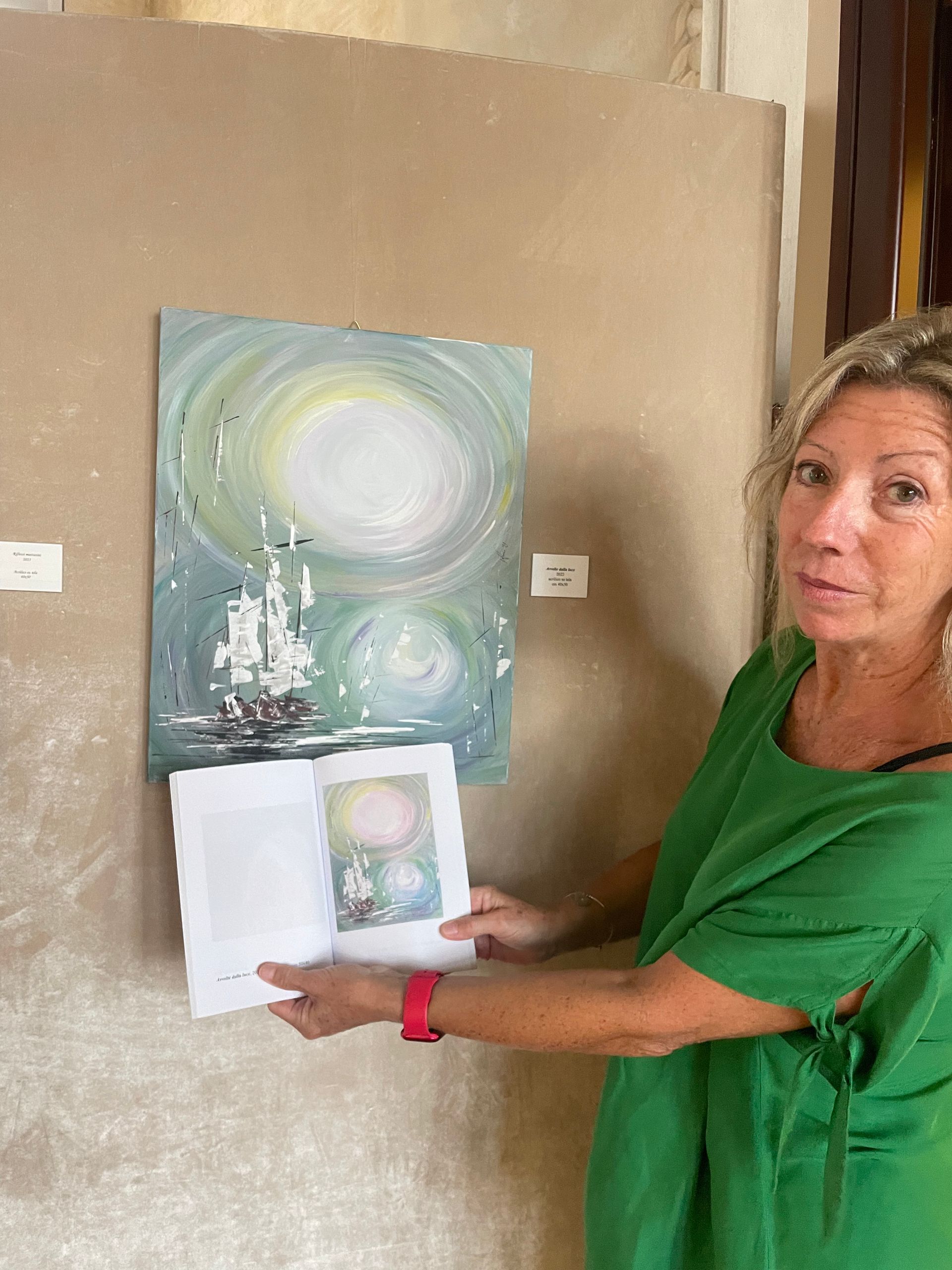Venice on Canvas: Interview with Fabiana Toffano
The flickers of light animating the exhibition at Ruzzini Palace
From July 4 to November 30, 2025, Ruzzini Palace Hotel hosts the solo exhibition Guizzi su tela (Flickers on Canvas) by Fabiana Toffano, a Venetian artist known for her instinctive and unique painting style.
The twenty-two works on display portray an intimate and dreamlike Venice—made up of blurred views, timeless figures, and above all, light—the true protagonist of her paintings.
We met the artist in the frescoed halls of the historic palace to talk about her creative process, her deep bond with the city, and the expressive “flicker” that gives the exhibition its title.
What emerged is an open and heartfelt conversation in which Toffano invites us into her world of visual memories, instinctive gestures, and silent dialogue with the viewer.
Here’s what she shared with us.
Venice is the main subject of your paintings. What is your earliest memory of painting linked to this city?
I’ve shown an interest in art since I was a child. I was born and raised in Venice, the ultimate city of art, and I’ve always been inspired by the colors of its corners and canals. I used to go out with my easel and oil paints with my first teacher—my mother’s brother—to paint en plein air. With my mother’s brother-in-law, I also began sketching designs for his wooden sculptures. My father was a master glassmaker in Murano—a great artist. I spent hours watching his glass creations come to life.

Your paintings seem to capture light more than form. What role does light play in your creative process?
Light is fundamental in my work. It’s a constant pursuit. I visually memorize the various reflections that filter through Venetian facades and canal views, and then narrate them through my brushstrokes, with strong contrasts between light and shadow. The light filtering through arches and across the architecture changes constantly. I don’t try to capture a static image, but rather the light as it transforms—and I bring that movement back onto the canvas.
The exhibition is titled Guizzi su tela. What does this “flicker” represent for you? Is it an emotion, a gesture, an intuition?
It’s an instinctive, quick gesture. I use medium to large brushes and don’t begin with drawings or clear ideas. It’s about transferring the emotions sparked by images stored in my memory, reinterpreted in a very personal way. The application of color is fast and decisive. These “flickers” are my signature—they convey motion, energy, and life. A flicker is that circular and immediate gesture that gives strength and vitality to my painting.
You often depict hidden corners or lesser-known views of Venice. How do you choose them? Is there a place you’re particularly fond of?
There’s no real selection process. My views are imagined, not real. Sometimes you can glimpse a recognizable building or bridge—like the Bridge of Sighs—but it’s always reinterpreted. The windows, arches, and outlines are different. I create a unique, blurred version of Venice—one that exists and doesn’t exist at the same time.
The figures in your paintings, often in costume, seem to float through time—suspended between history and imagination. Who are these characters to you?
They add even more movement to the scene. They’re never still—they walk through alleys, climb staircases. They remind me of people from the past, mysterious figures wearing wide-brimmed hats or bowlers, often embracing. As you said, they seem suspended between history and imagination. Many are women—the sinuousness of the female form adds grace and elegance.
Ruzzini Palace offers a setting very different from a traditional gallery. How did you experience the dialogue between your works and this historic space?
We deliberately chose a historic setting to enhance the works. I believe paintings like mine fit well in places such as Ruzzini. I’ve also exhibited at the Scuola Grande San Teodoro in my solo show Venezia curated by Silvia Landi last May, twice at the Museo Guidi in Forte dei Marmi, in 2023 and 2024, and at Galleria Europa in Camaiore in 2023. In February 2026, a solo exhibition is scheduled at the Delizia Estense del Verginese, in Gambulaga near Ferrara—all curated by Silvia Landi. The frescoed walls and historic atmosphere naturally and harmoniously dialogue with my works.
Your painting is often described as “instinctive.” How do you balance impulse and awareness while creating?
My works are born from bursts of creativity and energy, balanced by the awareness that comes with experience. The painting gesture is almost passionate—decisive and, at the same time, softened in places by the color. The brush follows an inner rhythm. It’s a fusion of instinct and technique developed over time.
What reaction from the public surprises you most when they view your works?
It’s very important for me to be present during exhibitions. At Ruzzini, being a hotel with constant clientele, it’s more difficult. I enjoy interacting with visitors and seeing how much curiosity and attention they give to the works. I love hearing their interpretations. Even though my paintings don’t need much explanation, I’ve noticed how different the perspectives can be from one person to another.
How has working with Silvia Landi influenced or enriched your artistic journey?
Working with Silvia has been a real enrichment. She’s a powerhouse of ideas. I still work on independent projects, of course, but with her there’s exchange, growth. She’s a passionate curator with experience and vision—a valuable guide for those who collaborate with her.
After Venice and before the upcoming exhibition at the Verginese in 2026, do you already have a new project or theme in mind?
There are ideas and proposals—it's hard for me to say no when something interesting comes along. I never stop. I’m always working, always thinking about the next flicker.
And it’s in that continuous flicker—made of movement, light, and emotion—that Venice keeps shining through the eyes and brush of Fabiana Toffano.




















































































































